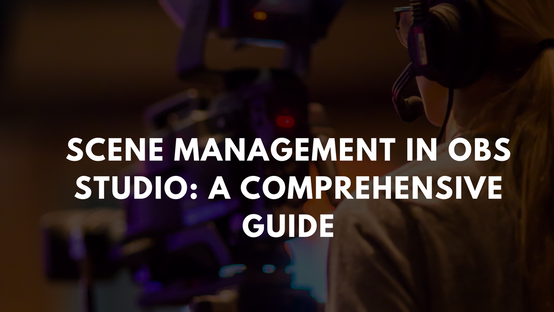|
Open Broadcaster Software (OBS) Studio is a versatile and powerful tool used by content creators, gamers, and professionals to broadcast and record videos. One of the key features that makes OBS Studio stand out is its scene management capabilities. Scenes allow you to control what your audience sees during your live stream or recording, making your content visually engaging and professional. In this comprehensive guide, we'll delve into the intricacies of scene management in OBS Studio and explore how you can use it to enhance your streaming and recording experience.
Understanding Scenes and Their Importance Scenes in OBS Studio are like different setups or layouts that you can switch between during your stream or recording. Each scene can contain multiple sources, which are elements such as video feeds, images, text, web browser windows, and more. By arranging and customizing these sources within scenes, you can create dynamic and visually appealing content that keeps your audience engaged. Check Article on:- OBS Studio Installation Guide Creating and Organizing Scenes To get started with scene management in OBS Studio, you'll need to create your scenes. Begin by identifying the types of scenes you'll need for your content. For instance, if you're streaming a video game, you might want separate scenes for the main gameplay, a webcam feed, overlays, and transitions. Adding Scenes: In OBS Studio, click the "+" button in the Scenes section to create a new scene. Give it a descriptive name to help you easily identify it. Adding Sources: Once you've created a scene, you can add sources to it. Sources can include your webcam, game capture, images, text, and more. Arrange these sources within the scene to achieve your desired layout. Scene Transitions: You can create smooth transitions between scenes to make your content visually appealing. OBS Studio offers various transition effects to choose from. Optimizing Scene Switching Efficient scene switching is crucial to maintaining a seamless streaming experience. Here are some tips to optimize the process: Hotkeys: Set up hotkeys to quickly switch between scenes during your stream without interrupting your content flow. Preview and Program: Use the "Preview" and "Program" windows to see how your scenes will transition before they're shown to your audience. Advanced Scene Management Techniques OBS Studio offers advanced features that can take your scene management to the next level: Scene Collections: Group related scenes into collections, which are useful when you're managing content for different games or themes. Scene Duplication: Duplicate scenes to save time when creating similar layouts for different parts of your stream. Tips for an Engaging Scene Setup Keep It Simple: Don't overcrowd your scenes with too many sources. A cluttered layout can distract your viewers. Check Article on:- OBS Studio's Best Practices Consistency: Maintain a consistent visual style across your scenes to give your content a polished and professional look. Practice and Testing: Experiment with your scenes before going live. Test different arrangements and transitions to ensure everything works smoothly. Conclusion Mastering scene management in OBS Studio opens up a world of creative possibilities for your content. By effectively using scenes and sources, you can create captivating live streams and recordings that resonate with your audience. Whether you're a gamer, a tutorial creator, or a professional presenter, OBS Studio's scene management tools are your gateway to producing high-quality, visually appealing content that leaves a lasting impression. Remember, scene management is an art that requires practice and experimentation. So dive in, explore the features, and craft scenes that enhance your content and engage your viewers in meaningful ways. Your streaming journey is about to get even more exciting with the power of OBS Studio's scene management capabilities. Comments are closed.
|
Philippe
|


 RSS Feed
RSS Feed
